Last updated: January 22, 2024
Any links on this page that lead to products on Amazon are affiliate links and I earn a commission if you make a purchase. Thanks in advance – I really appreciate it!
Have you ever wondered why cowboy boots have remained a staple in footwear fashion for decades? Contrary to its rugged, tough exterior, they’re actually comfortable. As someone who wears cowboy boots daily, I’ve experienced firsthand the surprising blend of style and comfort they offer, a secret well-kept within their leather stitches.
In this article, I’m diving deep to answer this often-asked question: Are cowboy boots really comfortable? This isn’t just a casual glance over popular opinions but a thorough exploration backed by personal experience and detailed research.
My goal is to unravel the layers of design, material, and craftsmanship that contribute to the comfort of cowboy boots, providing you with insights that go beyond the typical surface-level analysis. Whether you’re a seasoned boot wearer or considering your first pair, this article offers a comprehensive understanding of what makes these boots a comfort phenomenon in the world of footwear.
Pro Tip: Check out Ariat’s website before buying, they often have the best prices and latest styles of their boots.

Your Guide to Buying Comfortable Cowboy Boots
Selecting the perfect pair of cowboy boots involves more than just eye-catching designs; it’s about finding the right blend of comfort and style. Here’s your essential guide to ensure every step in your cowboy boots is as comfortable as it is stylish.
1. Prioritize Quality Materials
- Leather Types: Opt for high-quality leather for durability and a better fit over time.
- Cowhide: Renowned for its durability and ease of maintenance.
- Goat Leather: Offers a softer texture and natural flexibility.
- Exotic Leathers (Alligator, Snake): Known for unique patterns and luxury feel.
- Fabric Use: Consider boots with breathable linings for added comfort, especially in warmer climates.
- Mesh Linings: Enhance breathability, ideal for warmer climates.
- Insulated Fabrics: Provide warmth in colder conditions, maintaining comfort.
2. Check the Insole
- Cushioned Insoles: Often made of foam or gel, they adapt to the foot’s shape, providing personalized comfort.
- Padded Footbeds: Enhance support, especially beneficial for prolonged standing or walking.
- Arch Support: Ensure the insole provides good arch support, crucial for long-term wear.
3. Consider the Outsole
- Material: Rubber outsoles are great for shock absorption and suitable for prolonged wear.
- Traction: Ensure the outsole offers good grip, particularly if you’ll be wearing the boots outdoors or in slippery conditions.
4. Ensure Proper Fit
- Measure Your Feet: Always start with an accurate measurement of your feet. Remember, cowboy boot sizes might differ from your regular shoe sizes.
- Consider Width and Length: Cowboy boots come in various widths. Ensure the boot fits snugly but comfortably in both the width and length.
- Check the Instep: The fit around the instep (the top part of your foot) is crucial. It should be snug, as cowboy boots often lack laces or other tightening mechanisms.
- Heel Slippage: A little slippage in the heel is normal for new boots. This should lessen as the boots conform to your feet.
- Walk Around: Spend time walking in the boots to ensure there’s no pinching or discomfort. The boots should feel comfortable from heel to toe.
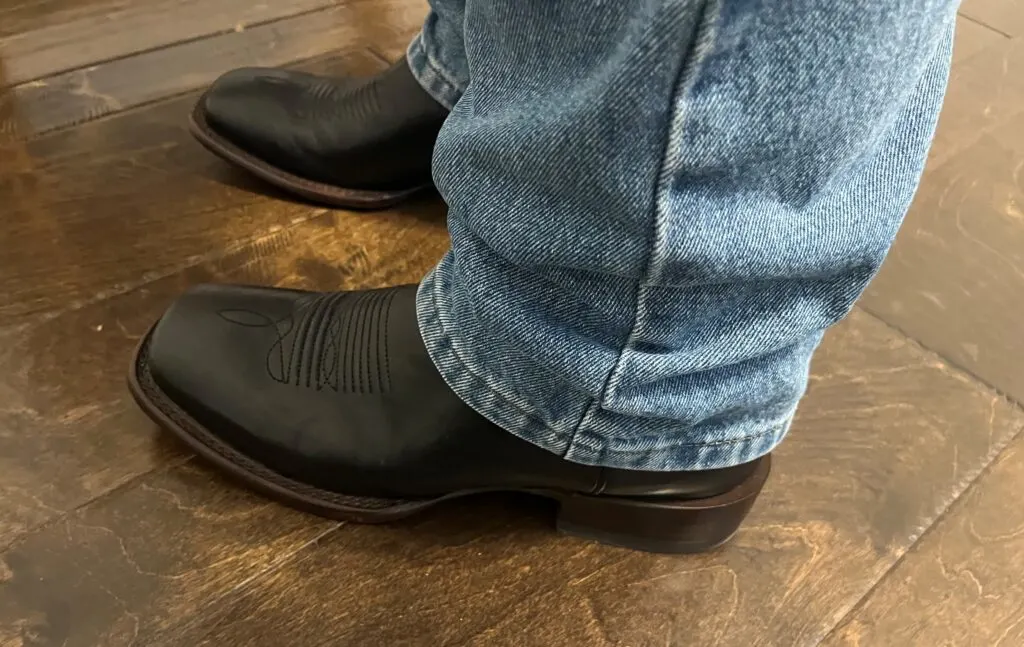
5. Examine the Toe Box
- Shape: Choose a toe box shape that suits your foot type for maximum comfort.
- Pointed Toes: Offer a traditional look but may be less roomy.
- Square Toes: Provide more space, reducing cramps and discomfort.
- Round Toes: A comfortable middle ground, balancing style and comfort.
- Space: Ensure there’s enough room for your toes to move without restriction.
6. Look for a Supportive Shank
- Arch Support: A good shank provides necessary arch support, reducing foot fatigue.
7. Consider Heel Type
- Walking Heels: These heels have a slight slant but are overall quite even and stable, offering extra comfort and balance. Ideal for those who spend a lot of time on their feet, walking heels are a practical choice for everyday wear.
When it comes to selecting the perfect pair of cowboy boots, comfort is just as crucial as style. Whether you’re a seasoned boot enthusiast or a first-time buyer, understanding how to choose a pair that offers both comfort and flair is key. Here’s your ultimate guide to buying comfortable cowboy boots.
Comparison with Other Footwear
Cowboy boots have long stood out in the footwear world, not just for their iconic style but also for their unique comfort features. Let’s compare them with regular shoes to understand what sets them apart.
Cowboy Boots vs. Regular Shoes: Comfort Comparison
- Support and Stability:
- Cowboy Boots: Typically feature a higher heel and sturdy construction, offering better ankle support and stability, especially on uneven terrains.
- Regular Shoes: Often have flatter soles and less ankle support, suitable for urban environments but may lack the robust support for rugged use.
- Fit and Comfort:
- Cowboy Boots: Designed to fit snugly, molding to the shape of the foot over time, providing a customized comfort experience.
- Regular Shoes: Generally offer immediate comfort with more flexibility, but may not provide the same level of personalized fit as cowboy boots.
- Durability:
- Cowboy Boots: Crafted for longevity with high-quality materials, they are built to withstand harsh conditions.
- Regular Shoes: While practical for daily use, they may not match the durability and ruggedness of cowboy boots.
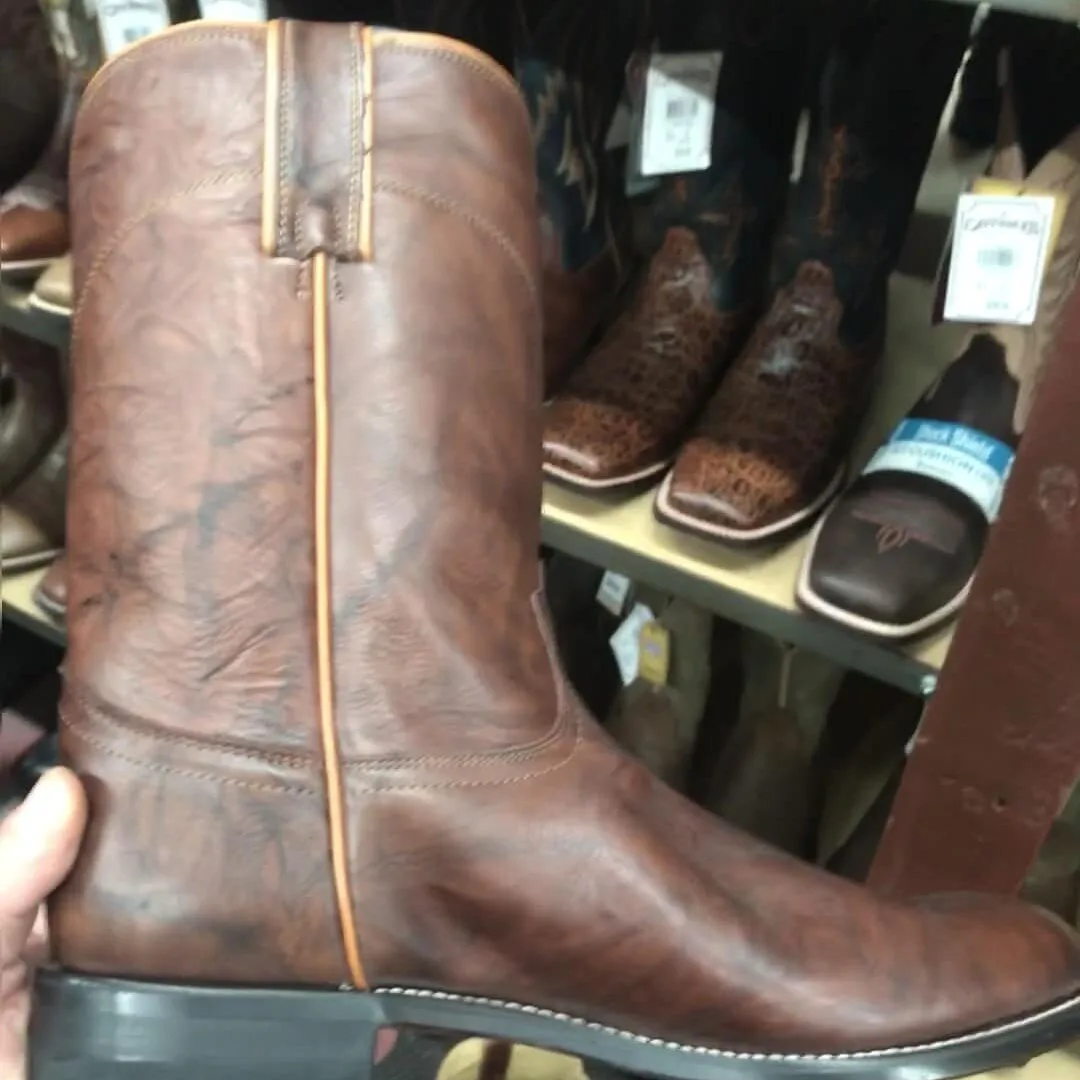
Specialized Features: Unique Aspects of Cowboy Boots
- Heel Design: Cowboy boots often have a distinct heel design (such as the riding heel) that aids in horseback riding but also provides a unique aesthetic and comfort aspect for everyday wear.
- Toe Shape: The variety in toe shapes (pointed, square, round) caters to different comfort needs and style preferences, a feature less varied in regular shoes.
- Material and Craftsmanship: The use of premium leathers and detailed craftsmanship in cowboy boots offers a level of quality and comfort that is hard to find in regular footwear.
- Cultural and Fashion Statement: Beyond comfort, cowboy boots carry a cultural significance and fashion statement that regular shoes often don’t provide.
While regular shoes are designed for everyday ease and practicality, cowboy boots offer a unique blend of comfort, durability, and style, making them a versatile choice for various occasions and lifestyles.
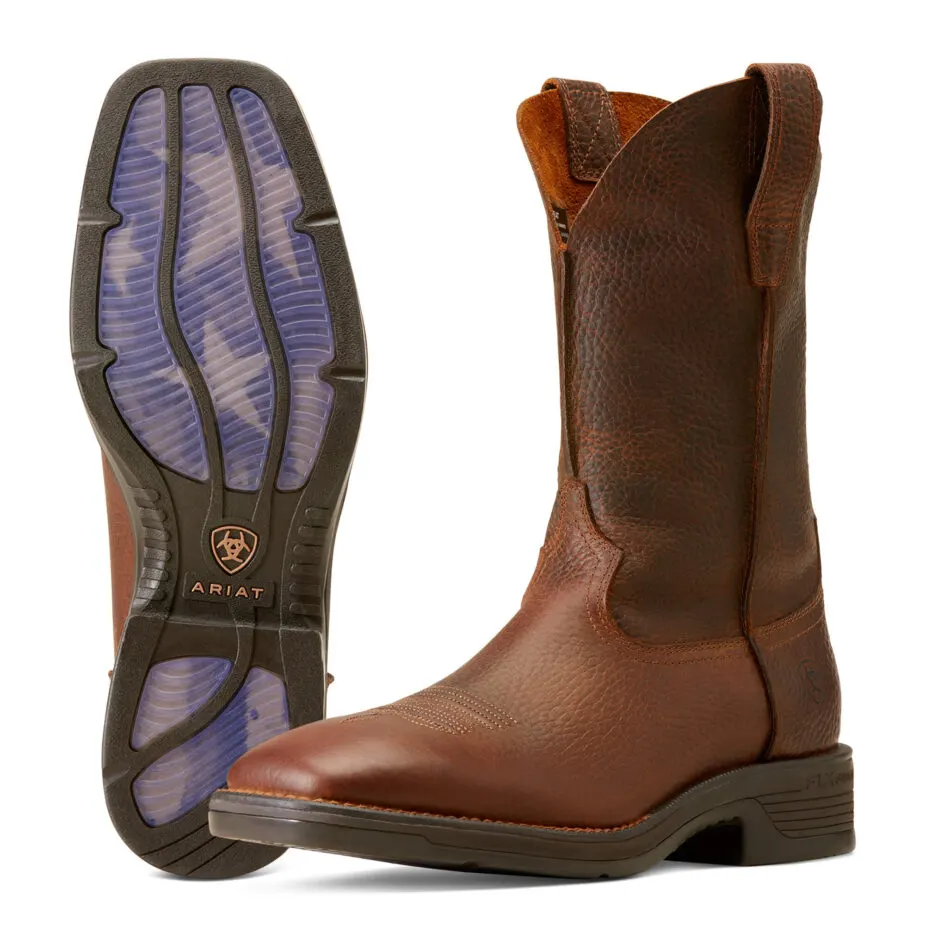
Ultimate Comfort: Reviews of My Favorite Cowboy Boots
For Men
- Ariat Ramblers
- Experience: As a regular wearer, I find the Ariat Ramblers to be the epitome of comfort and style. The wide toe box provides ample space.
- Design: These boots boast a rugged look that pairs well with both casual and outdoor attire. The footbed conforms to the foot over time, enhancing the comfort with each wear.
- Key Feature: The supportive sole is a standout, providing stability and ease, especially during long hours of wear.
- Justin Ropers
- Horseback Riding: Ideal for equestrian activities, these boots have become a personal favorite for horseback riding. Their heel design ensures a secure fit in the stirrups.
- Comfort: The low heels of Justin Ropers are akin to typical walking shoes, offering comfort that lasts throughout the day. In or out of the saddle, these boots are comfortable.
- Versatility: Beyond riding, their classic design makes them suitable for everyday wear, blending seamlessly with various styles.
- Ariat Amos
- All-Day Comfort: The Ariat Amos boots stand out for their all-day comfort. Wearing them regularly, I appreciate their ergonomic design that eases foot strain. Amos boots are my go-to everyday footwear.
- Style: These boots strike a perfect balance between traditional cowboy aesthetics and modern flair, making them versatile for different occasions.
- Durability: Built to last, the Ariat Amos boots maintain their comfort and style even with heavy use.
Customer Reviews
- Ariat Ramblers: Customers rave about durability and comfort, especially praising the soft leather that molds to their feet, making long hours on their feet a breeze. Source.
- Justin Ropers: Reviewers often mention the exceptional craftsmanship and comfort that stand out in both rural and urban settings. Source.
- Ariat Amos: Many highlight the versatility of these boots, noting how they seamlessly transition from work to casual wear without compromising on comfort or style. Source.
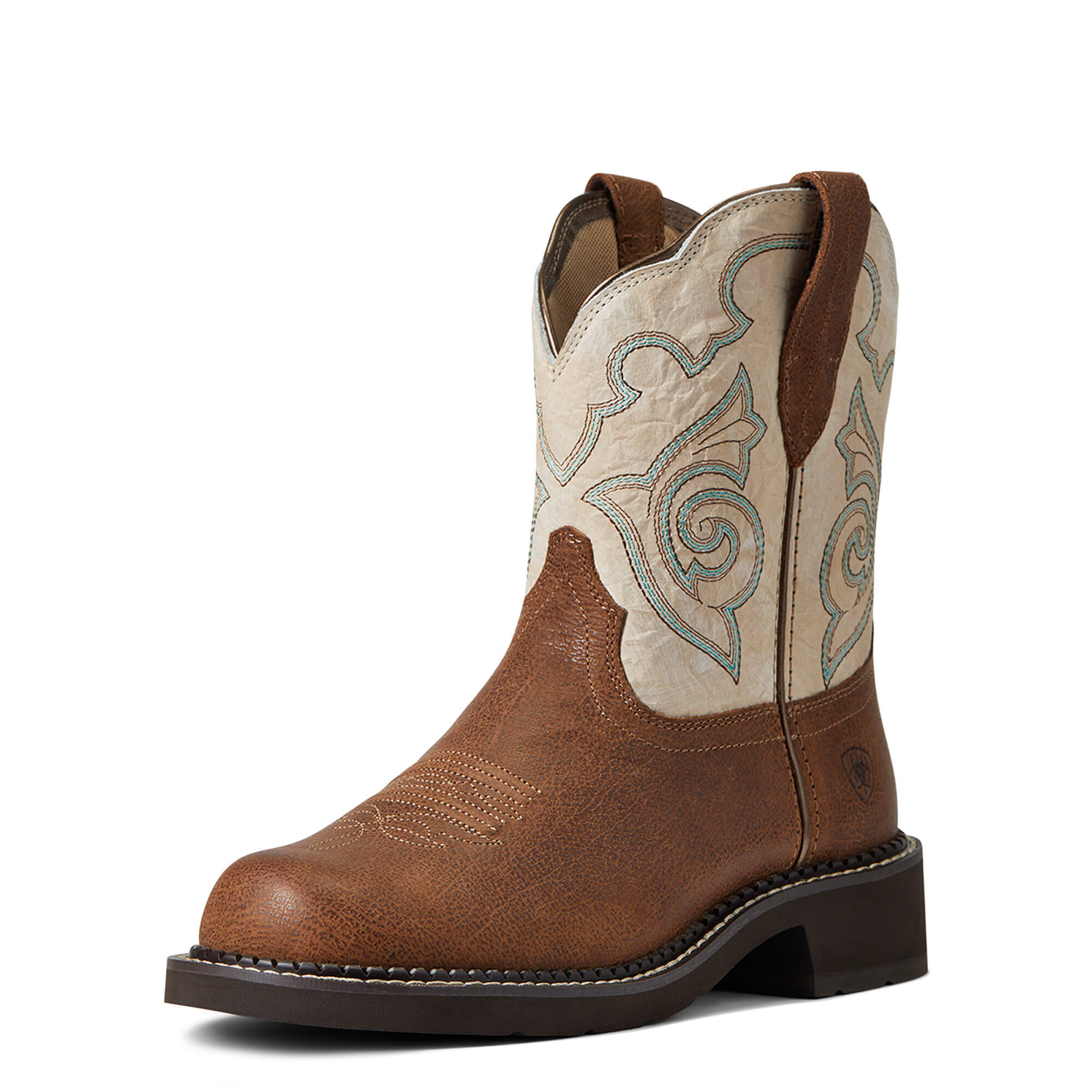
For Women
- Ariat Fatbaby Heritage
- Comfortable Fit: Known for their snug and comfortable fit, these boots are a delight to wear. The cushioned footbed adds an extra layer of comfort.
- Stylish Design: The Fatbaby Heritage boots offer a stylish look that complements a variety of outfits, from jeans to skirts.
- Durability: These boots are not just about looks; their durability makes them a practical choice for both casual and outdoor activities. The robust construction ensures they hold up well over time.
- Soda Reno
- Fashion-Forward: The Soda Reno boots blend comfort with a trendy design, making them a great choice for those who prioritize both style and comfort.
- Versatility: These boots are versatile enough to be worn for various occasions, from a day out in the city to more casual settings.
- Fit and Feel: The boots offer a comfortable fit right out of the box, with minimal break-in time required, which is a significant plus for new wearers.
- Justin Women’s Gypsy Ropers
- Equestrian Ready: The women in my family who enjoy horseback riding find these boots to be perfectly suited for the activity. Their design provides both comfort and functionality in the saddle.
- All-Day Comfort: The Gypsy Ropers are designed for all-day wear, with a comfortable insole that supports the foot, making them as suitable for work as they are for leisure.
- Durable and Stylish: These boots are not only durable but also feature a stylish design that stands out, making them a favorite for both riding and everyday wear.
Each of these boots has been personally tested and stands out for their unique blend of comfort, style, and durability, catering to a variety of needs and preferences.
Below is a helpful YouTube video that points out which styles of cowboy boots are most comfortable.
User Experience and Testimonials
The true testament to the comfort and appeal of cowboy boots lies in the stories and experiences of those who wear them. I spoke to a few of my friends who wear cowboy boots daily, and they provided some of their real-world experiences.
Personal Stories
- Competitive Rodeo Calf Roper: “As someone who’s spent countless hours in the saddle, my cowboy boots have been more than just footwear. They’ve been a reliable partner, providing unmatched comfort and support, no matter the conditions.”
- The Urban Cowboy: “I never thought cowboy boots would fit into my lifestyle, but they’ve become my go-to. They offer a unique blend of style and comfort that my regular shoes just can’t match.”
- The Fashion Enthusiast: “Cowboy boots have transformed my wardrobe. They’re not just comfortable; they make a statement. Every time I wear them, it feels like I’m wearing a piece of art.”
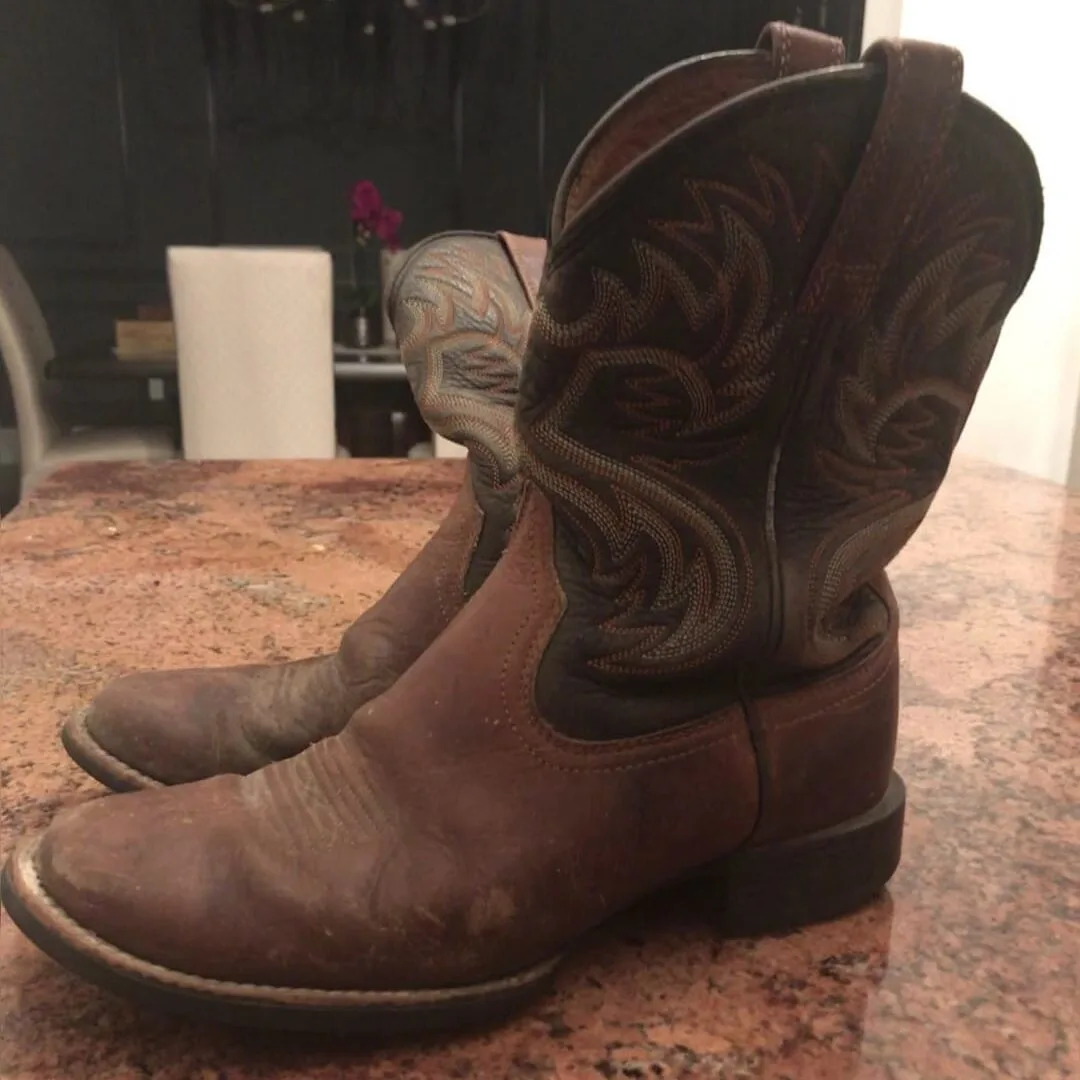
Maintenance and Care for Comfort
Ensuring your cowboy boots remain as comfortable as the day you bought them involves more than just regular wear; it requires ongoing care. Here’s how you can keep your boots in top shape for lasting comfort.
Care and Maintenance
- Regular Cleaning: Wipe your boots with a damp cloth after each wear to remove dirt and dust. Use a cleaner specifically designed for leather if necessary.
- Conditioning: Regularly apply a quality leather conditioner to keep the leather supple and prevent cracking.
- Proper Storage: Store your boots in a cool, dry place. Use boot trees or stuff them with newspaper to maintain their shape.
- Avoid Water Damage: While some cowboy boots are water-resistant, it’s best to avoid prolonged exposure to water. If they do get wet, let them dry naturally away from direct heat.
- Resoling and Repairs: Monitor the soles and heels for wear. Professional resoling or repair can significantly extend the life of your boots.
By following these maintenance practices, you can ensure your cowboy boots continue to provide the same level of comfort and style as they did on day one. Remember, a little care goes a long way in preserving the unique charm and comfort of your cowboy boots.
Choose the Right Style of Cowboy Boots for Comfort.
Not all cowboy boots are designed the same. Some are specially made for horseback riding, while others are built for outdoor work. When choosing a boot for comfortable walking, buy one with a moderate heel and mid-length shaft.
There are five primary styles of Cowboy boots:
- Classic western boots have no laces, a 12-inch shaft, and a 1 1/2 to 2-inch angled heel designed to keep a foot from sliding through a stirrup. To read about stirrups, click the link.
- Ropers‘ have a heel that is only about 1 inch and typically is squared off, and the shaft rises slightly above the ankles and has a flexible sole. Classic ropers have a rounded toe but are also available in square-toed styles.
- Western work boots have heels that are less than 2 inches with soles made of rubber or another composite material designed for traction. The shaft typically comes to the midcalf, and the toe box is rounded or squared.
- Stockman boots have a short and wide heel. And it also has a wide-toe box with rubber soles. The shaft is typically ornate.
- Buckaroo boots have elongated decorative shafts more than 14 inches in height. The heels on these boots are often over 2 inches in height.
The most comfortable style of cowboy boots for everyday walking are ropers, stockmen, and western work boots. Their low-profile heels provide support and balance, and the toe box is wide enough to make walking around in them a pleasurable experience.
If you are always on your feet, consider one of these cowboy boot styles for your next footwear. If you’re looking for a pair of riding boots that are also good hiking boots, click on the link.
Breaking in Cowboy Boots for Optimal Comfort
Breaking in new cowboy boots is an essential step in ensuring they provide the utmost comfort. This process molds the boots to the unique shape of your feet and can greatly enhance the overall fit and feel. Here are steps to break in your cowboy boots effectively and an explanation of how this process contributes to comfort.
- Steps for Breaking in New Boots
- Start with Short Periods: Begin by wearing your boots for short durations at home. Gradually increase the amount of time you spend in them.
- Use Leather Conditioner: Applying a quality leather conditioner can soften the leather, making it more pliable and comfortable.
- Flex the Soles: Gently bend the soles of the boots back and forth to loosen them up. Be careful not to overdo it and damage the boot.
- Wear Thick Socks: Initially, wear thicker socks to protect your feet and provide extra padding. This can also help stretch the leather slightly.
- Use a Boot Stretcher: If certain areas feel too tight, consider using a boot stretcher, especially for the width of the boot.
- Moisture and Heat Method: Some people use a method where they dampen the boots with a little water and then wear them until they dry, conforming to their feet. Be cautious with this method, as too much water can damage the leather.
- How the Break-In Process Enhances Comfort
- Molds to Your Feet: As leather warms up and adjusts to the pressure points of your feet, it stretches and molds to your foot’s shape, providing a custom fit.
- Reduces Hot Spots: Initial stiffness can cause discomfort or blisters. Breaking in the boots reduces these hot spots by softening the leather in areas of friction.
- Improves Flexibility: New boots can be rigid. The break-in process increases their flexibility, making it easier to walk, bend, and move in them.
- Enhances Longevity: Properly broken-in boots distribute wear and tear more evenly, potentially extending the life of your boots.
- Personalization: The process makes your boots uniquely yours, not just in fit but also in how they crease and wear over time, adding to their character and comfort.
Breaking in your cowboy boots is a crucial step towards achieving optimal comfort. It’s a process that not only enhances the fit but also personalizes the boot to your foot, ensuring that the boots become more comfortable with each wear. Remember, patience is key; breaking in quality cowboy boots takes time, but the resulting comfort and fit are well worth the effort.
Conclusion
In this comprehensive guide to cowboy boots, we’ve unraveled the mystery behind their comfort and appeal. Let’s recap the key points we’ve explored:
- Design Features: Cowboy boots offer a winning combination of quality materials, cushioned insoles, and supportive shanks that contribute to their comfort.
- Comparison with Other Footwear: Cowboy boots provide a unique blend of comfort, durability, and style that sets them apart from regular shoes.
- User Experience and Testimonials: Personal stories and customer reviews highlight the real-world comfort and versatility of cowboy boots.
- Maintenance and Care: Proper fitting and regular maintenance are essential to ensuring the lasting comfort of your cowboy boots.
- Historical Context and Evolution: Cowboy boots have evolved from practical ranching footwear to become a symbol of American heritage and fashion.
- The Ultimate Guide to Buying Comfortable Cowboy Boots: We’ve provided a comprehensive guide to help you select the most comfortable cowboy boots, including tips and top brands for both men and women.
Final Verdict: Are Cowboy Boots Comfortable?
Absolutely, cowboy boots are comfortable! When chosen wisely, they offer a level of comfort that’s unmatched in the world of footwear. With the right fit, quality materials, and proper care, you can enjoy long-lasting comfort, whether you’re working on the ranch, exploring the urban jungle, or making a bold fashion statement.
Call to Action
Now that you’re armed with knowledge about what makes cowboy boots comfortable, it’s time to explore different brands and styles to find the perfect pair for you. Whether you’re a seasoned cowboy boot enthusiast or a newcomer, the world of comfortable and stylish options awaits.
Don’t hesitate to share your own cowboy boot experiences or seek recommendations from fellow boot aficionados. Your journey to ultimate comfort and style starts here, so step into those boots and make your own stories in comfort and confidence.
FAQs
Are cowboy boots comfortable for all-day wear?
Cowboy boots can be comfortable for all-day wear, provided they are well-fitted and made from quality materials. Proper insoles, shank support, and a good fit contribute to comfort.
Do cowboy boots require a break-in period?
Yes, many cowboy boots require a break-in period to fully conform to your feet. This process can vary depending on the boot’s material and design.
Are pointed toe cowboy boots less comfortable than round toe ones?
Pointed toe cowboy boots can be comfortable if they fit properly. However, round toe boots often provide more room for toes, making them a preferred choice for some individuals.
What should I consider when choosing cowboy boots for horseback riding?
For activities like horseback riding, look for boots with a supportive shank, low heels for secure stirrup placement, and a comfortable fit to prevent chafing or discomfort during prolonged rides.
Meet Miles Henry
An avid equestrian and seasoned racehorse owner, Miles Henry brings his extensive experience to the equine world, proudly associating with the AQHA, The Jockey Club, and various other equine organizations. Beyond the racetrack, Miles is an accomplished author, having published various books about horses, and is a recognized authority in the field, with his work cited in multiple publications.
🔗 Connect with Miles:
Twitter
Facebook
YouTube: Check out race highlights, horse care tips, and more!

